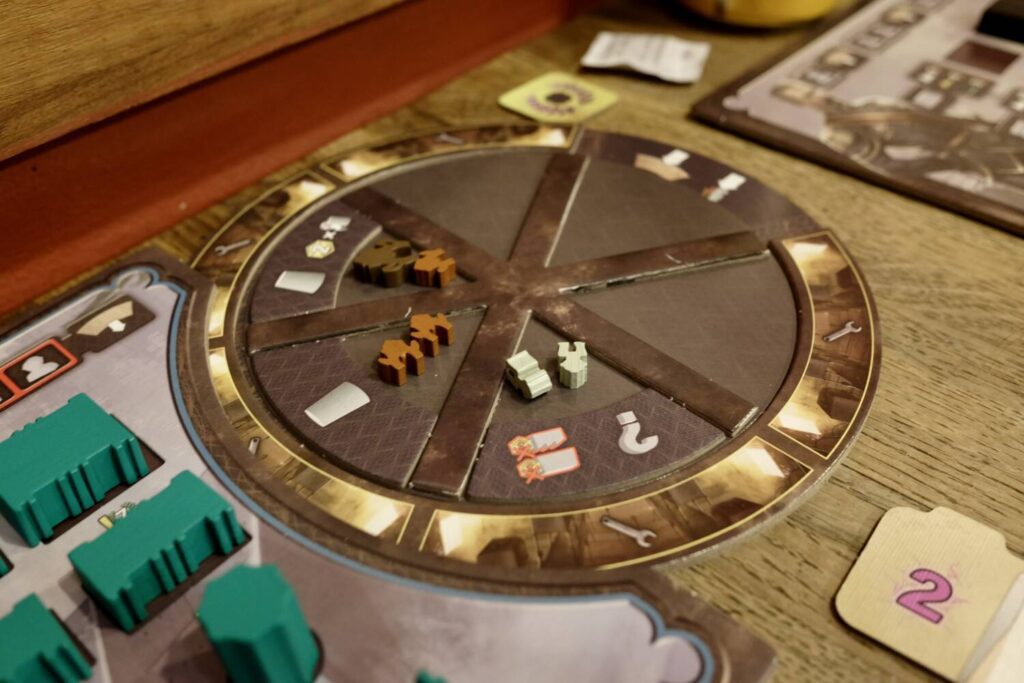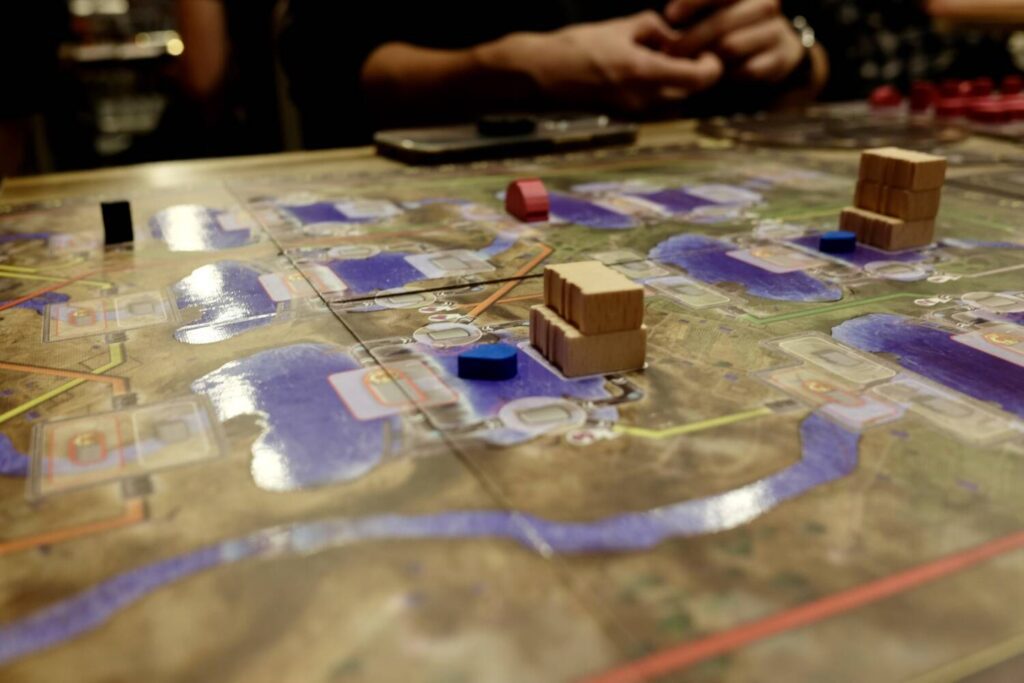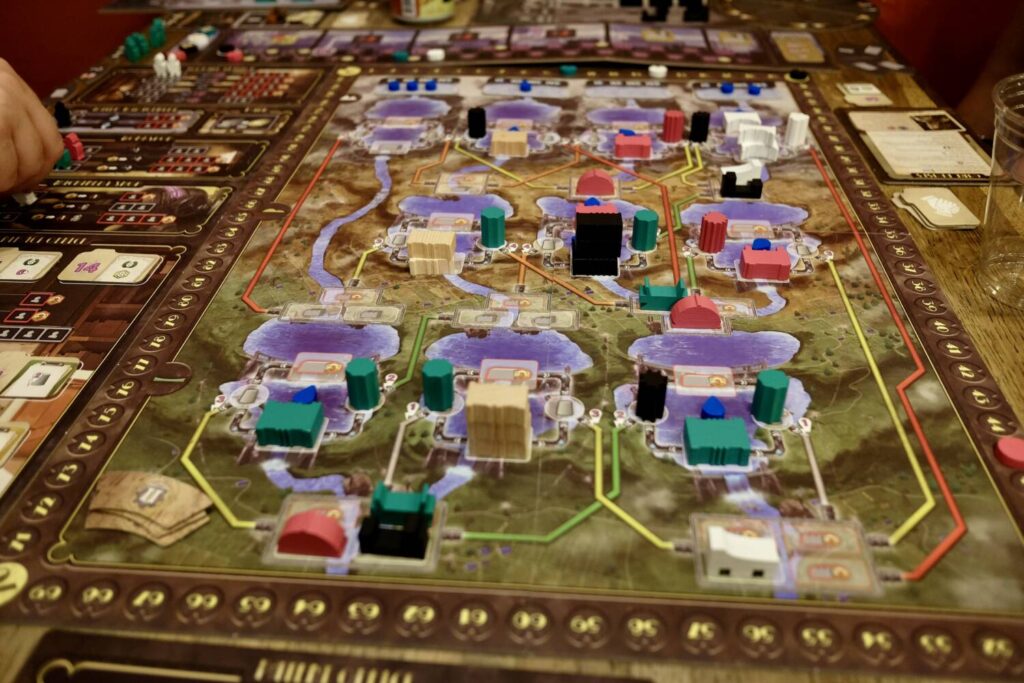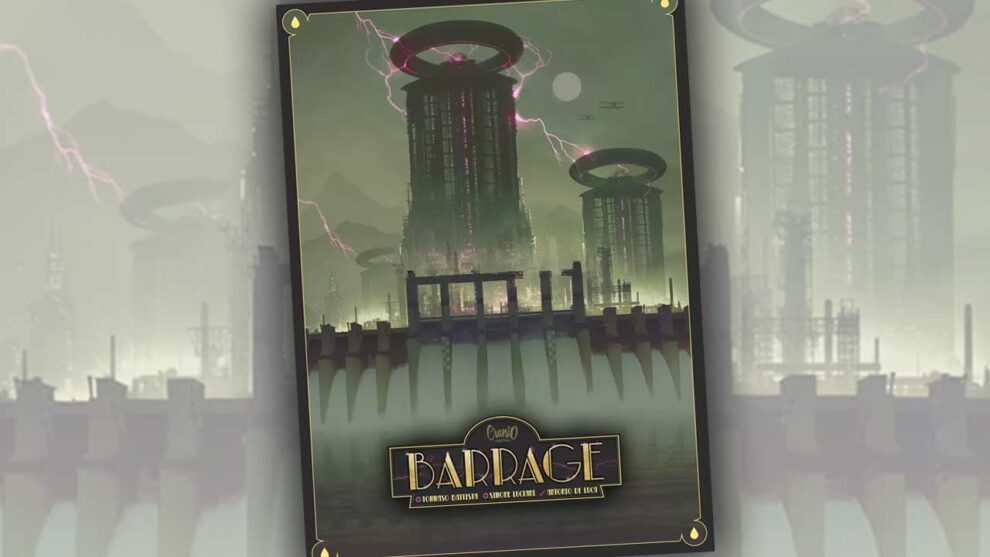Disclosure: Meeple Mountain received a free copy of this product in exchange for an honest, unbiased review. This review is not intended to be an endorsement.
I don’t generally care for worker placement. Games that focus on that mechanic generally don’t have space for a whole lot of the particular kind of creativity that I look for. It doesn’t help that worker placement is usually paired with resource management, which I find tiresome. I would have had a tough time in the hobby ca. 2012.
Each genre on its own encourages and rewards efficiency above anything else, and that’s simply not my vegetable. The other problem, which is related, is the lack of interactivity. Yes, obviously, you can take someone else’s spot, but that doesn’t quite do it for me. There’s something too black-and-white, the course corrections are too obvious.
Barrage, by designers Tommaso Battista and Simone Luciani and published in 2019 by Cranio Creations, is a worker placement and resource management game. From the above, you’d have to assume that this isn’t promising. I myself was unsure.
Miracle of miracles: I love Barrage.
When the Levee Breaks
It’s the 1930s. The world has consumed all available fossil fuels. The sole remaining power source adequate for the Industrial Revolution is hydroelectric power. Each player is a nationalized hydroelectric company attempting to control power production in the Alps. Over the course of five rounds, you build dams, conduits, and powerhouses with which to produce power.
Much of Barrage is cut-and-dry Euro. You place the required number of workers on an available action space, pay any necessary resource costs, and perform the action. At the beginning of each round, you gain income connected to what you’ve built over the course of the game. Each player has two unique powers, one inherent to the company board they choose and the other determined by a randomly assigned Executive Officer. Points are scored at the end of each round, based on bonus criteria determined during setup. If you’re not new to modern board games, this is a surprisingly breezy teach for a game with a BGG weight of 4.10. It helps that it has a terrific manual.
While action selection is straightforward, things get interesting once you throw in the Construction Wheel. It wouldn’t be a Simone Luciani codesign without a wheel. When you build, you must have the corresponding tile at your disposal. I can’t build the foundation for one of my dams unless I have the Base or Wild Tile available, for example. That tile is placed on the active slot of your Construction Wheel, along with any resources you must commit to the project.

Unlike most resource management games, you get your resources back. Every time the Construction Wheel rotates, any tiles or resources on the new active slot are released back to the player. It makes sense. If I owned a construction company, I wouldn’t have to permanently sacrifice machinery to a project. It would be booked and unavailable until that project is complete. That’s a cool, fun twist that fits the theme, but this doesn’t explain why Barrage breaks free of my disinterest.
The Spice Water Must Flow
Let us turn now to the central board. Here we see the Alps, full of beautiful mountain peaks and surging rivers. At the top of the board are the ice caps, whose slow summer melt releases a near-constant supply of freshwater. Below that, following the rivers, are ten basins in three rows. These basins are where you build your dams and powerhouses. This is also where the player interaction happens.

To generate power, you need a dam, a conduit, and a powerhouse. The dam has to either be one of the three neutral dams placed during setup, or it has to belong to you. Nobody else can touch water held at one of your dams. The conduit can belong to anybody. If it’s yours, it’s free to use. If it’s a rental, you pay the owner. The powerhouse also has to be yours, and it has to be in one of the two locations connected to your dam via pipe and conduit.
Dams can be extended, which increases their water capacity. The more drops of water that are held in your dam, the more power you can generate with a single action. At the end of each round, there’s a water phase, during which the melt is released into the rivers, flowing until it hits a stopping point. If your dam exceeds its capacity, that water flows over the top and continues downstream, where another enterprising dam builder may be waiting. Higher spaces are more expensive to build in, which makes sense; you get priority access to the water up there.
Each time someone generates power, the water is piped through the appropriate powerhouse and into another basin. This is not always the basin directly below the dam the water came from. Each basin is connected to two powerhouse locations, and one of them is always off to one side or the other. Placement of dams and position in action tempo—meaning you know you can do something you want to do before anyone else can do it—are the core of Barrage, and seeing opportunities to draft off of your opponents’ efforts is a huge part of the game. If someone is setting up a large dam, it couldn’t hurt to set up your own large dam in the basin where all of their water is going to come out. Unless, of course, someone gets there first.
Barrage is an unforgiving, brutal landscape. Players, especially experienced players, are at one another’s throat for the entire game. If you aren’t careful, you can get frozen out. This is not a good game for those who can’t handle tight competition, or devastating plays that are waved off as “just business.”
In my first game, I pushed the conduits too hard, and suffered for it. I realized my error about halfway through the second round, and was ultimately able to make adjustments to get back into a competitive state. It is to the game’s credit that you can survive making those errors. Another of the smarter design choices was putting the worker spaces for construction on each player’s Company board, instead of on the central board. Everyone has the same number of construction actions available to them every round. That means you can never be stopped from building by others taking those action slots—don’t worry, they’ll build where you want to build plenty—and, by the same token, you can never take build actions for granted.

Dammed If You Do, Dammed If You Don’t
The interactivity of Barrage’s economy is what gets me. Like Brass: Birmingham, to which it is often compared, this is a viper’s nest of interconnected decisions. I don’t think Barrage is quite as dynamic as Brass, but it’s also nowhere near as fussy. I could teach a well-versed table how to play Barrage in about ten minutes, moving at a comfortable pace. I definitely could not do that with Brass.
Each game of Barrage, I have walked away thinking about different choices I could have made, different ways to capitalize on the board state, or the systems, or my Company power, or, or, or. The morning after my first game, I woke up thinking about it. I don’t know if Barrage is the kind of game that will endure as a favorite past the point of my having fully explored it. There may be limits. But those limits are far, far away, and in the meantime? Hoo baby, do I love Barrage.












I have played this game once with my friend, Steve. I would have to say that you had the same overall experience I had. Barrage is a very cool game that I would love to play again.
Now… one of these days we will have to talk about resource management and worker placement… 🙂
Not much to talk about! Haha. It’s a matter of taste, not a matter of quality. I would never argue that worker placement or resource management are bad mechanisms, and both are parts of games I love very much, but they don’t tend to come with games I love.